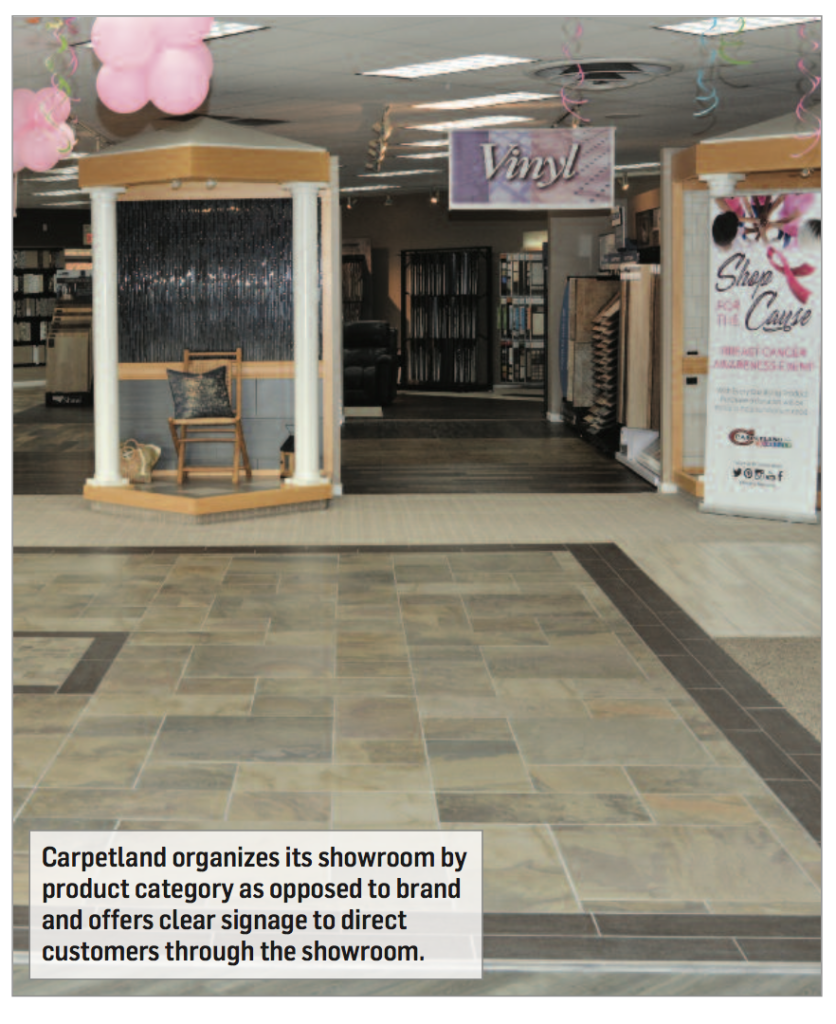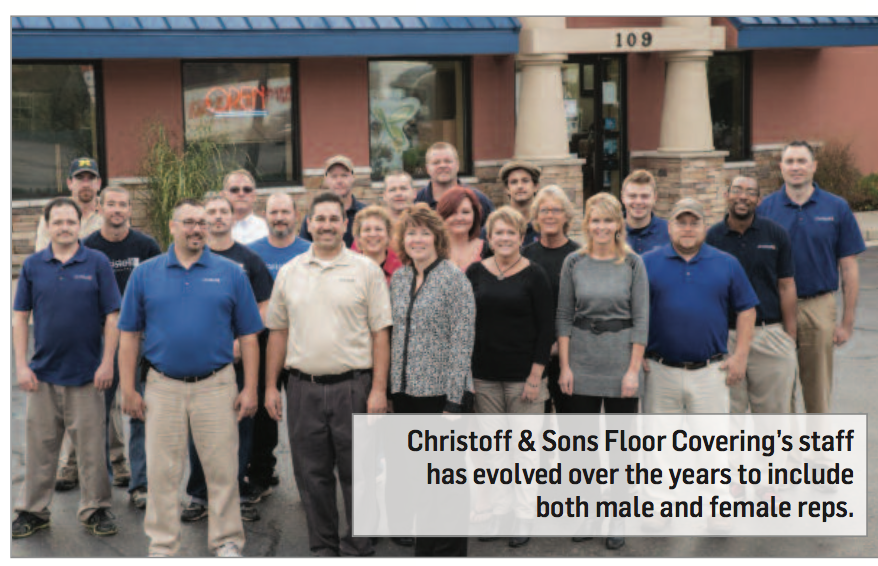January 21/28, 2019: Volume 34, Issue 17
By Nicole Murray
 There are multiple aspects that affect whether a flooring company achieves success: showroom design, customer interaction and even the ability to relate to consumers. However, it is important to realize these different variables are always evolving to make the shopping experience easier and more comfortable for the customers.
There are multiple aspects that affect whether a flooring company achieves success: showroom design, customer interaction and even the ability to relate to consumers. However, it is important to realize these different variables are always evolving to make the shopping experience easier and more comfortable for the customers.
There have been some major changes that have occurred within the flooring industry over the past 20 years. Following is a look at some of them.
Showroom designThe showroom is no longer viewed as a space solely meant for product displays. Companies should also include additional features that offer a homey feel, such as open areas for customers to use while designing or to relax while shopping.
“Our showroom features open working islands so clients have a neutral area to design comfortably and pull samples to compare side by side,” said Lauren Voit, president of Great Western Flooring, Naperville, Ill. “It breaks up the room and gives the customers a space they can feel ‘off duty’ if need be.”
Retailers said a minimal number of products on the showroom floor can help better utilize the space. It is beneficial to minimalize nearly identical product options available.
“We have very little on the floor now as opposed to 20 years ago, when the showroom was a large part of our inventory storage design,” said Mike Peters, owner of CarpetsPlus, Madison, Wis. “We only show two or three products that look identical so there is room for other options, and it keeps the showroom looking clean and spacious.”
The displays themselves have also expanded to more aesthetically pleasing options, including stand-alone manufacturer displays, vignettes and wall displays to create a fashion-forward environment as opposed to the plain racks that were used in years past.
“The displays have started to look more like furniture to dress up the products and create a showroom that is current and stylish,” said Eric Thompson, owner of Satolli Carpet & Floor Covering, Warren, Ohio. “If we cannot make our showrooms appealing, why would end users trust our opinions to affect how they design their homes?”
Douglas Bertrand, vice president of Carpetland USA, Davenport, Iowa, agreed. “Showcasing full room displays helps the customer think of the big picture. These rooms spark design ideas of how to incorporate our products into their home, which makes them more likely to buy.”
Ted Christoff, owner of Christoff & Sons Floor Covering, Jackson, Mich., suggested using larger samples to give the shopper the opportunity to visualize what the  product will look like in her own home. “The old sample boards and racks are simply not inspiring. We’re taking away half the work for her by showing what the product will look like on a larger scale.”
product will look like in her own home. “The old sample boards and racks are simply not inspiring. We’re taking away half the work for her by showing what the product will look like on a larger scale.”
Displays are also now housing products in neutral colors as end users look for long-term investments that will stay in style as trends change.
“People are veering toward neutral colors, so they can leave the flooring on longer but will still have a product that can mix and match well in different design themes,” Thompson said. “These days, people want to invest in flooring that will last 15 to 20 years as opposed to replacing it every five years or so.”
It is also a time saver to organize a showroom by product type as opposed to brand because shoppers often ask for a product based on specific attributes. “Brand-loyal customers are fewer and farther between because finding a product that fits their situation is the top priority,” Thompson noted. “A lot of end users have asked for LVT, for example, so they’ll only be shown options that are easily maintainable and affordable. Once they meet their checklist, they will make their final decision based on visuals.”
Another significant change that has taken place across many showroom floors over the past few decades has been the seismic shift from carpet to hard surface. Observers say it directly correlates to consumer tastes. “At least 75% of our floor space was dedicated to carpet years ago,” said Kenneth Stevens, vice president of CarpetsPlus, Madison, Wis. “Now, hard surfaces such as LVT and LVP have become the largest growing products and as a result take more floor space to give the consumers what they want.”
Customer interactionThe introduction of the Internet has completely changed the way companies interact with their customers. In a lot of cases, a consumer will develop an opinion based on social media, the quality of a company’s website and customer service capabilities before face-to-face contact has even been made.
“We have put a lot of effort into our website because we want to give customers a reason to stay on our site and view who we are, what our mission statement is, product catalogs and free measure set-ups, which can ultimately lead to a sale,” Stevens said. “It gives customers the opportunity to interact the way they want to interact.”
When consumers utilize interactive platforms and social media, the ability to establish contact and learn what they need can be done conveniently faster.
“The Internet has really helped us establish contact with customers, especially millennials, who don’t like to take the time or have the time to shop,” Peters said. “They can browse the products and brands we carry and can make a lot of decisions before they come in.”
Peters is not alone. Satolli Carpet & Floor Covering has a Facebook page full of interaction. “I am shocked at the number of places that don’t have a website or social media presence,” Thompson said. “It opens the door to an immense number of new customers.”
However, the Internet has made pricing much more competitive due to cost comparisons, which can be done with the click of a button. “Customers can see if there is a cheaper alternative right in front of you because the information is so easily available,” Great Western’s Voit said. “Customer loyalty becomes a big challenge because competitors can use the readily available price information to lower theirs by even a few dollars, which is enough to steal business.”
In addition, end users can easily self-educate, which means sales staff must be more prepared to answer detail-oriented questions. “We have our staff read trade journals, spend a lot of time researching online and looking at websites of stores in other markets,” Thompson said. “A consumer who does a lot of research is not necessarily a better educated customer, so the job of educating ourselves is never complete.”
Shifting demographicsThe number of female sales reps has increased throughout the industry, dealers say, which can be attributed to the fact the consumer is usually female. According to Christoff, women are still the decision makers and want to be assisted by someone they can connect with. The consumer ultimately wants to feel understood and confident when making her long-term investment.
Thompson agreed. “Our clientele continues to be female, and even though I am well-versed in flooring I will always call over a female to get her opinion because that is usually who she listens to as it is a familiar source.”
Millennials are another prime demographic playing a major role in the evolution of the flooring industry. They are currently seen as the future of the business and must be incorporated into the staff as they are the voice on social media platforms impacting the trends and popular design choices.
“The millennial and younger demographics are the future and need to be represented in the ranks because they are having an effect on what we sell now,” Peters explained. “Plus, youthful staffers are far more likely to recruit or refer acquaintances to apply, which is a huge bonus for the future.”
